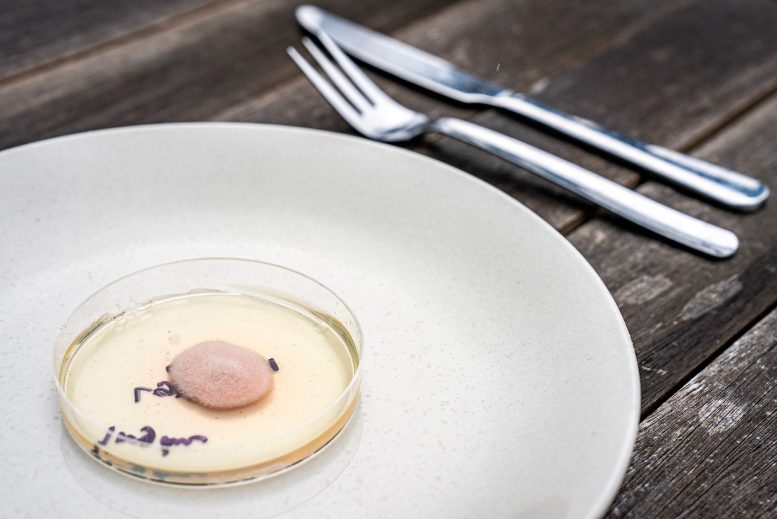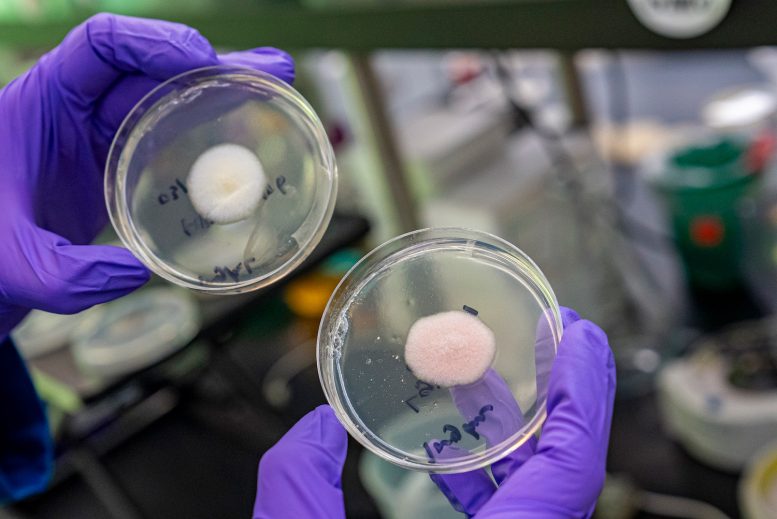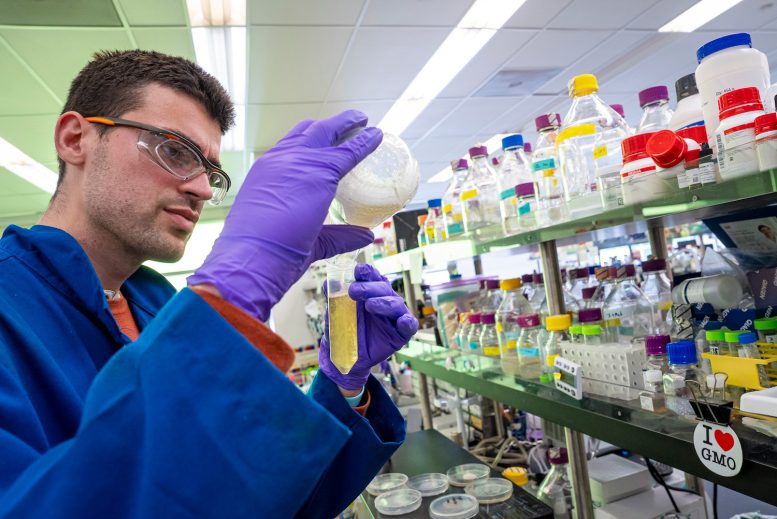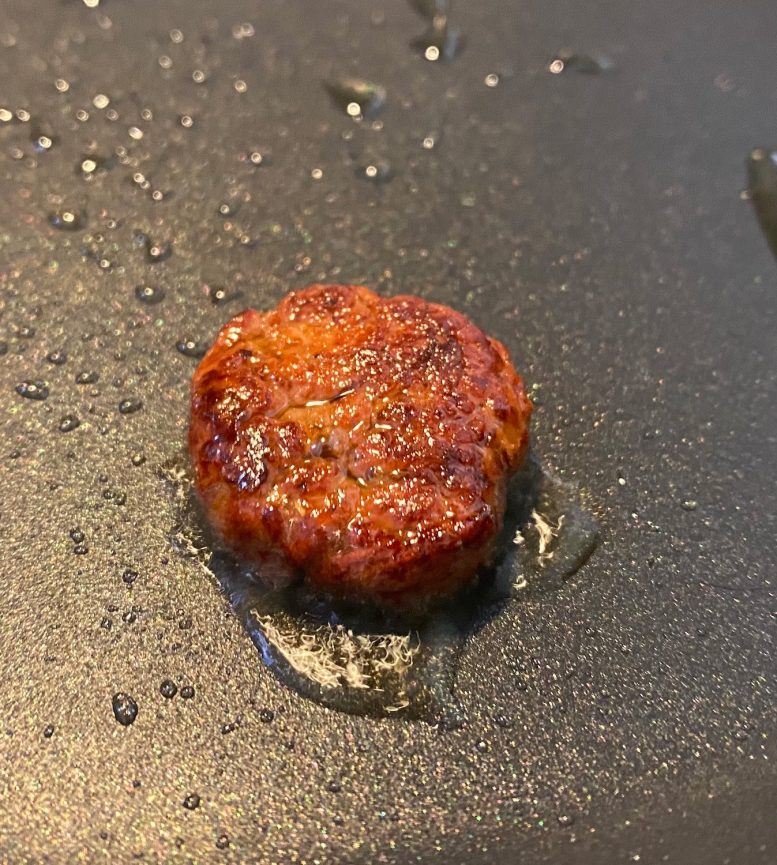
Posted on 04/30/2024 11:19:59 AM PDT by Red Badger

Advances in biotechnology are transforming food production with fungi playing a pivotal role. Research led by Vayu Hill-Maini utilizes genetic engineering to enhance fungi’s natural properties, creating nutritious and sustainable meat alternatives. This approach not only opens new avenues in food science but also integrates sophisticated culinary applications. A gene-edited fungal culture from Vayu Hill-Maini’s research, seen on a dinner plate. Credit: Marilyn Sargent/Berkeley Lab
Hacking the genome of fungi for smart foods of the future.
With animal-free dairy products and convincing vegetarian meat substitutes already on the market, it’s easy to see how biotechnology can change the food industry. Advances in genetic engineering are allowing us to harness microorganisms to produce cruelty-free products that are healthy for consumers and healthier for the environment.
One of the most promising sources of innovative foods is fungi – a diverse kingdom of organisms that naturally produce a huge range of tasty and nutritious proteins, fats, antioxidants, and flavor molecules. Chef-turned-bioengineer Vayu Hill-Maini, an affiliate in the Biosciences Area at Lawrence Berkeley National Laboratory (Berkeley Lab), is exploring the many possibilities for new flavors and textures that can be made from modifying the genes already present in fungi.

The petri dish on the left contains the natural koji mold, whereas the one on the right has been engineered to contain higher levels of a nutrient called ergothioneine and more heme – an iron-based molecule found in many organisms, but is especially abundant in animal tissues, which gives meat a distinctive flavor. Credit: Marilyn Sargent/Berkeley Lab
“I think it’s a fundamental aspect of synthetic biology that we’re benefiting from organisms that have evolved to be really good at certain things,” said Hill-Maini, who is a postdoctoral researcher at UC Berkeley in the lab of bioengineering expert Jay Keasling. “What we’re trying to do is to look at what is the fungus making and try to kind of unlock and enhance it. And I think that’s an important angle that we don’t need to introduce genes from wildly different species. We’re investigating how we can stitch things together and unlock what’s already there.”
Genetic Enhancements in Fungi
In their recent paper, recently published in the journal Nature Communications, Hill-Maini and colleagues at UC Berkeley, the Joint BioEnergy Institute, and the Novo Nordisk Foundation Center for Biosustainability studied a multicellular fungus called Aspergillus oryzae, also known as koji mold, that has been used in East Asia to ferment starches into sake, soy sauce, and miso for centuries. First, the team used CRISPR-Cas9 to develop a gene editing system that can make consistent and reproducible changes to the koji mold genome. Once they had established a toolkit of edits, they applied their system to make modifications that elevate the mold as a food source.
First, Hill-Maini focused on boosting the mold’s production of heme – an iron-based molecule which is found in many lifeforms but is most abundant in animal tissue, giving meat its color and distinctive flavor. (A synthetically produced plant-derived heme is also what gives the Impossible Burger its meat-duping properties.) Next, the team punched up production of ergothioneine, an antioxidant only found in fungi that is associated with cardiovascular health benefits.

First author Vayu Hill-Maini in the lab at the Joint BioEnergy Institute in Emeryville, California. Credit: Marilyn Sargent/Berkeley Lab
After these changes, the once-white fungi grew red. With minimal preparation – removing excess water and grinding – the harvested fungi could be shaped into a patty, then fried into a tempting-looking burger.
Hill-Maini’s next objective is to make the fungi even more appealing by tuning the genes that control the mold’s texture. “We think that there’s a lot of room to explore texture by varying the fiber-like morphology of the cells. So, we might be able to program the structure of the lot fibers to be longer which would give a more meat-like experience. And then we can think about boosting lipid composition for mouth feel and further nutrition,” said Hill-Maini, who was a Fellow of the Miller Institute for Basic Research in Science at UC Berkeley during the study. “I’m really excited about how can we further look at the fungus and, you know, tinker with its structure and metabolism for food.”
Though this work is just the beginning of the journey to tap into fungal genomes to create new foods, it showcases the huge potential of these organisms to serve as easy-to-grow protein sources that avoid the complex ingredients lists of current meat substitutes and the cost barriers and technical difficulties hindering the launch of cultured meat. Additionally, the team’s gene editing toolkit is a huge leap forward for the field of synthetic biology as a whole.
Currently, a great variety of biomanufactured goods are made by engineered bacteria and yeast, the single-celled cousins of mushrooms and mold. Yet despite humanity’s long history of domesticating fungi to eat directly or to make staples like miso, multicellular fungi have not yet been harnessed as engineered cellular factories to the same extent because their genomes are far more complex, and have adaptations that make gene editing a challenge. The CRISPR-Cas9 toolkit developed in this paper lays the foundation to easily edit koji mold and its many relatives.

The small koji mold patty after frying. Credit: Vayu Hill-Maini
“These organisms have been used for centuries to produce food, and they are incredibly efficient at converting carbon into a wide variety of complex molecules, including many that would be almost impossible to produce using a classic host like brewer’s yeast or E. coli,” said Jay Keasling, who is a senior scientist at Berkeley Lab and a professor at UC Berkeley. “By unlocking koji mold through the development of these tools, we are unlocking the potential of a huge new group of hosts that we can use to make foods, valuable chemicals, energy-dense biofuels, and medicines. It’s a thrilling new avenue for biomanufacturing.”
Bridging the Laboratory and the Kitchen
Given his culinary background, Hill-Maini is keen to ensure that the next generation of fungi-based products are not only palatable, but truly desirable to customers, including those with sophisticated tastes. In a separate study, he and Keasling collaborated with chefs at Alchemist, a two-Michelin-starred restaurant in Copenhagen, to play with the culinary potential of another multicellular fungus, Neurospora intermedia. This fungus is traditionally used in Indonesia to produce a staple food called oncom by fermenting the waste products left over from making other foods, such as tofu. Intrigued by its ability to convert leftovers into a protein-rich food, the scientists and chefs studied the fungus in the Alchemist test kitchen.
They discovered N. intermedia produces and excretes many enzymes as it grows. When grown on starchy rice, the fungi produces an enzyme that liquifies the rice and makes it intensely sweet. “We developed a process with just three ingredients – rice, water, and fungus – to make a beautiful, striking orange-colored porridge,” said Hill-Maini. “That became a new dish on the tasting menu that utilizes fungal chemistry and color in a dessert. And I think that what it really shows is that there’s an opportunity to bridge the laboratory and the kitchen.”
Reference:
“Edible mycelium bioengineered for enhanced nutritional value and sensory appeal using a modular synthetic biology toolkit” by Vayu Maini Rekdal, Casper R. B. van der Luijt, Yan Chen, Ramu Kakumanu, Edward E. K. Baidoo, Christopher J. Petzold, Pablo Cruz-Morales and Jay D. Keasling, 14 March 2024, Nature Communications. DOI: 10.1038/s41467-024-46314-8
Hill-Maini’s work on the gene editing research described in this article is supported by the Miller Institute at UC Berkeley. Keasling’s lab is supported by the Novo Nordisk Foundation. Both received additional support from the Department of Energy (DOE) Office of Science. The Joint BioEnergy Institute is a DOE Bioenergy Research Center managed by Berkeley Lab.
Fungus Burgers! YUMMMY!....................
Uh... it’s not changing what *WE* eat...
It may be changing what *Y’ALL* eat.
I eat real food.
Pass.
My daughter, who hasn’t turned 2 yet, loves eating mushrooms. She would probably like this.
I like a giant portobello burger.
Mushrooms, along with garlic, onions, anchovies, ground beef and tomato sauce, rank among God’s great gifts to mankind.
I’m willing to give this a taste. In the long run, industrial scale production of cultured foods will be essential for any deep space exploration and human colonies on the moon or beyond. And it will help in tight patches on Earth as well.
Just keep the WokeWorld commissars from turning it into a mandate and let the free market work it out.

I will be selling kits to grow your own food in your ass crack.
“I will be selling kits to grow your own food in your (butt) crack.”
No ***t?
"What's for dinner, Mom?"
"Fermented waste products!"
"Oh boy! That's my favorite!"
First big laugh of the day. Thanks! :)
P.S. I’m not interested in what you’re selling, though...
Hard Pass!
And for the HUNDREDTH time - learn to grow some of your own fruits and veggies. Learn to bake a simple loaf of bread. Raise meat animals if you have the room and the inclination. Raise chickens for eggs and meat. Hunt. Fish. Preserve.
Shop the PERIMETER of your grocery store - THAT is where the ‘real’ food is. Stay out of the MIDDLE of the store and the frozen foods (except for Seafood if you’re land-locked like me!) It’s filled with JUNK!
*Steps Off Soapbox* :)
Cancer Cuisine
If we ever get to the point of having to eat dog meat, that little yapper next door is on the menu!...............
Disclaimer: Opinions posted on Free Republic are those of the individual posters and do not necessarily represent the opinion of Free Republic or its management. All materials posted herein are protected by copyright law and the exemption for fair use of copyrighted works.